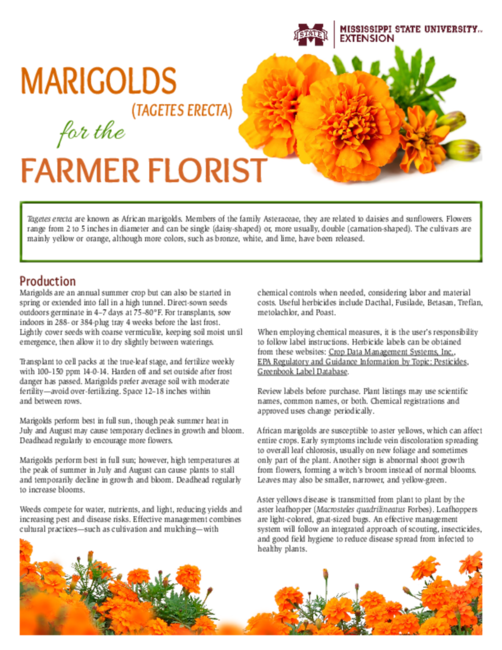P3362
Marigolds (Tagetes erecta) for the Farmer Florist

Tagetes erecta are known as African marigolds. Members of the family Asteraceae, they are related to daisies and sunflowers. Flowers range from 2 to 5 inches in diameter and can be single (daisy-shaped) or, more usually, double (carnation-shaped). The cultivars are mainly yellow or orange, although more colors, such as bronze, white, and lime, have been released.
Production
Marigolds are an annual summer crop but can also be started in spring or extended into fall in a high tunnel. Direct-sown seeds outdoors germinate in 4–7 days at 75–80°F. For transplants, sow indoors in 288- or 384-plug tray 4 weeks before the last frost. Lightly cover seeds with coarse vermiculite, keeping soil moist until emergence, then allow it to dry slightly between waterings.
Transplant to cell packs at the true-leaf stage, and fertilize weekly with 100–150 ppm 14-0-14. Harden off and set outside after frost danger has passed. Marigolds prefer average soil with moderate fertility—avoid over-fertilizing. Space 12–18 inches within and between rows.
Marigolds perform best in full sun, though peak summer heat in July and August may cause temporary declines in growth and bloom. Deadhead regularly to encourage more flowers.
Marigolds perform best in full sun; however, high temperatures at the peak of summer in July and August can cause plants to stall and temporarily decline in growth and bloom. Deadhead regularly to increase blooms.
Weeds compete for water, nutrients, and light, reducing yields and increasing pest and disease risks. Effective management combines cultural practices—such as cultivation and mulching—with chemical controls when needed, considering labor and material costs. Useful herbicides include Dacthal, Fusilade, Betasan, Treflan, metolachlor, and Poast.
When employing chemical measures, it is the user’s responsibility to follow label instructions. Herbicide labels can be obtained from these websites: Crop Data Management Systems, Inc., EPA Regulatory and Guidance Information by Topic: Pesticides, Greenbook Label Database.
Review labels before purchase. Plant listings may use scientific names, common names, or both. Chemical registrations and approved uses change periodically.
African marigolds are susceptible to aster yellows, which can affect entire crops. Early symptoms include vein discoloration spreading to overall leaf chlorosis, usually on new foliage and sometimes only part of the plant. Another sign is abnormal shoot growth from flowers, forming a witch’s broom instead of normal blooms. Leaves may also be smaller, narrower, and yellow-green.
Aster yellows disease is transmitted from plant to plant by the aster leafhopper (Macrosteles quadrilineatus Forbes). Leafhoppers are light-colored, gnat-sized bugs. An effective management system will follow an integrated approach of scouting, insecticides, and good field hygiene to reduce disease spread from infected to healthy plants.
Harvest and Handling
Harvest marigolds when flowers are starting to open. The stems, when cut, should be 24–32 inches long. Place them in water immediately and hold at 36–41˚F. No preservative or conditioning is recommended. Marigolds have a vase life of a week or more. Mostly used fresh, marigolds are also suitable for drying.
Cultivar Recommendations
Giant Series
Large flower heads average 3 inches in diameter atop sturdy stems. They are prolific producers as cut flowers and reach a height of 36–40 inches in 70–90 days. Research conducted at Mississippi State University’s Coastal Research and Extension Center has shown this series to be an excellent performer for Mississippi growers.
Jubilee Mix
Fully double flowers measure 5 inches across in shades of yellow, gold, and orange on 24- to 36-inch stems. These are suitable for fall markets because of their autumnal hues. As with most African marigolds, they have highly scented foliage, which may be stripped from the stems.
Design Applications
Arrangement
A blue and white pottery container is a good choice for a mass-pattern arrangement of marigolds (Tagetes erecta ‘Giant Orange’). This design used fresh flower foam mechanics, but the container could easily hold crumpled chicken wire held in place with waterproof florist tape. Orange is the direct complement of blue, so any blue container or background would provide high contrast to these flowers. A design such as this would fit perfectly on a console table against a plain wall or mirror. Larger marigolds were placed deeper in the design for focal impact.
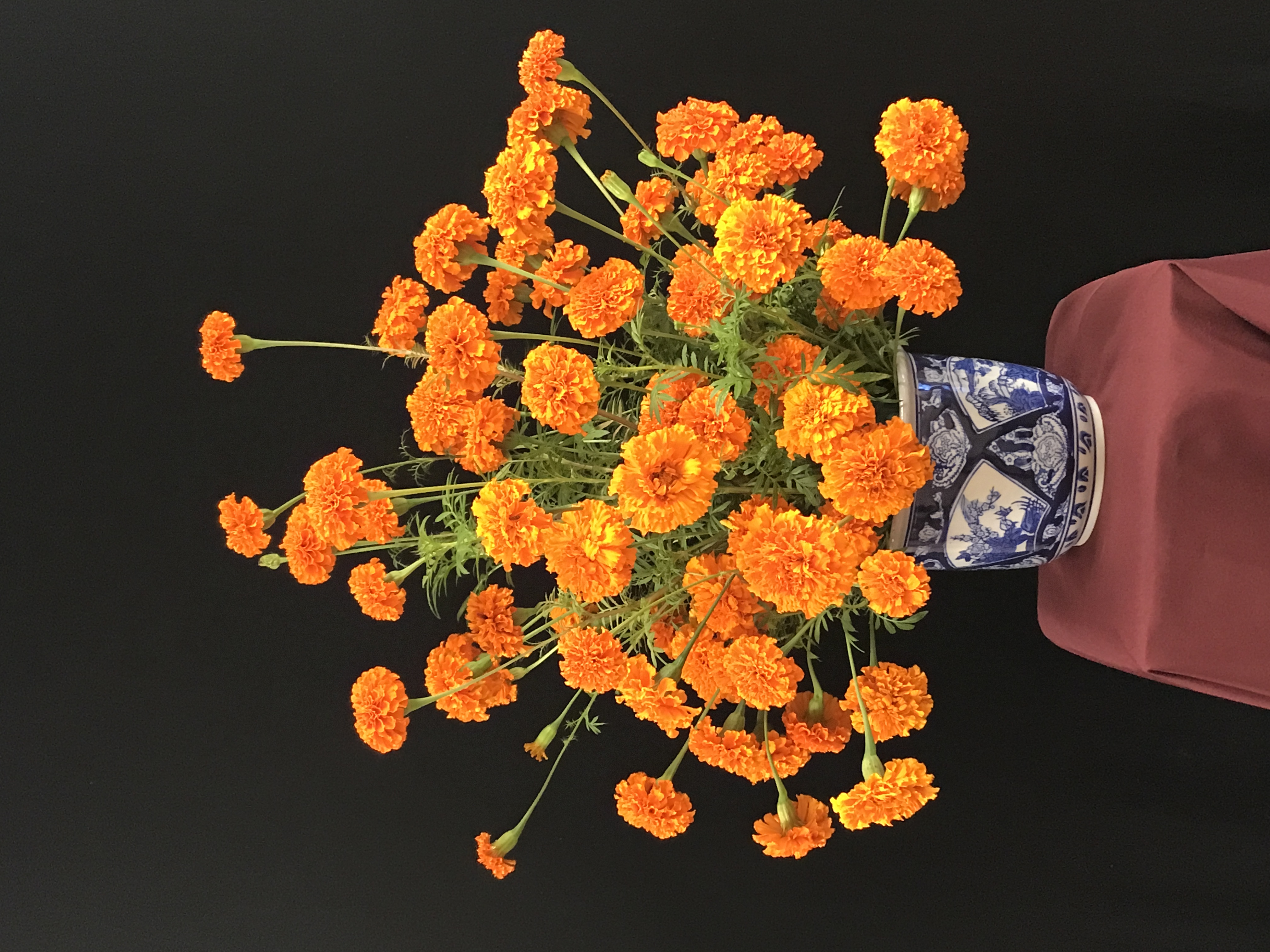
Centerpiece
A hurricane lantern container holds fresh flower foam and approximately 30 marigolds accented with camellia leaves. Evening receptions call for candles, and bright-colored flowers show up well in their subdued light. These orange marigolds will take on a burnished gold appearance at night.
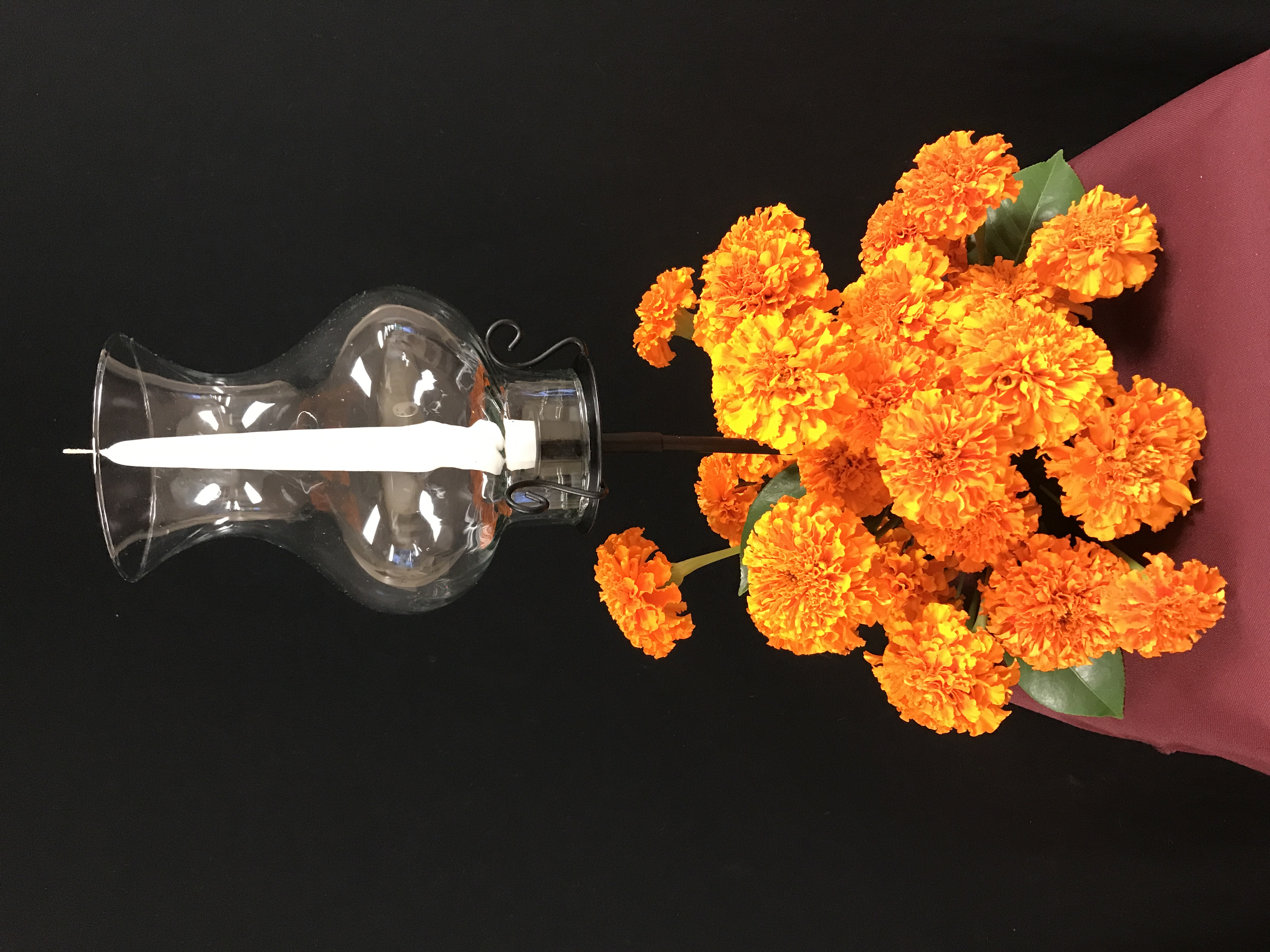
Cultural Floral Design
Marigold garlands are a traditional floral design in the Hindu faith, used in celebrations, ceremonies, or offerings to a god or spirit. The flower symbolizes success, prosperity, and favorable outcomes. Yellow and orange signify surrender to a higher being. In this setting, a Lord Buddha shrine features a backdrop of three garden trellis panels held together with cable ties. Marigold flower heads were selected based on uniformity and size (approximately 3 inches across) and strung on heavy thread using a 2-inch needle.

Corsage/Boutonniere
Marigolds can be used successfully in flowers-to-wear designs. The boutonniere features camellia foliage as an accent, while the shoulder corsage is surrounded by variegated ivy leaves. All materials are mounted on 24-gauge wire using pierce or cross-pierce methods, then wrapped with paper-based corsage tape. Misting with an anti-transpirant spray will keep the designs fresher longer.
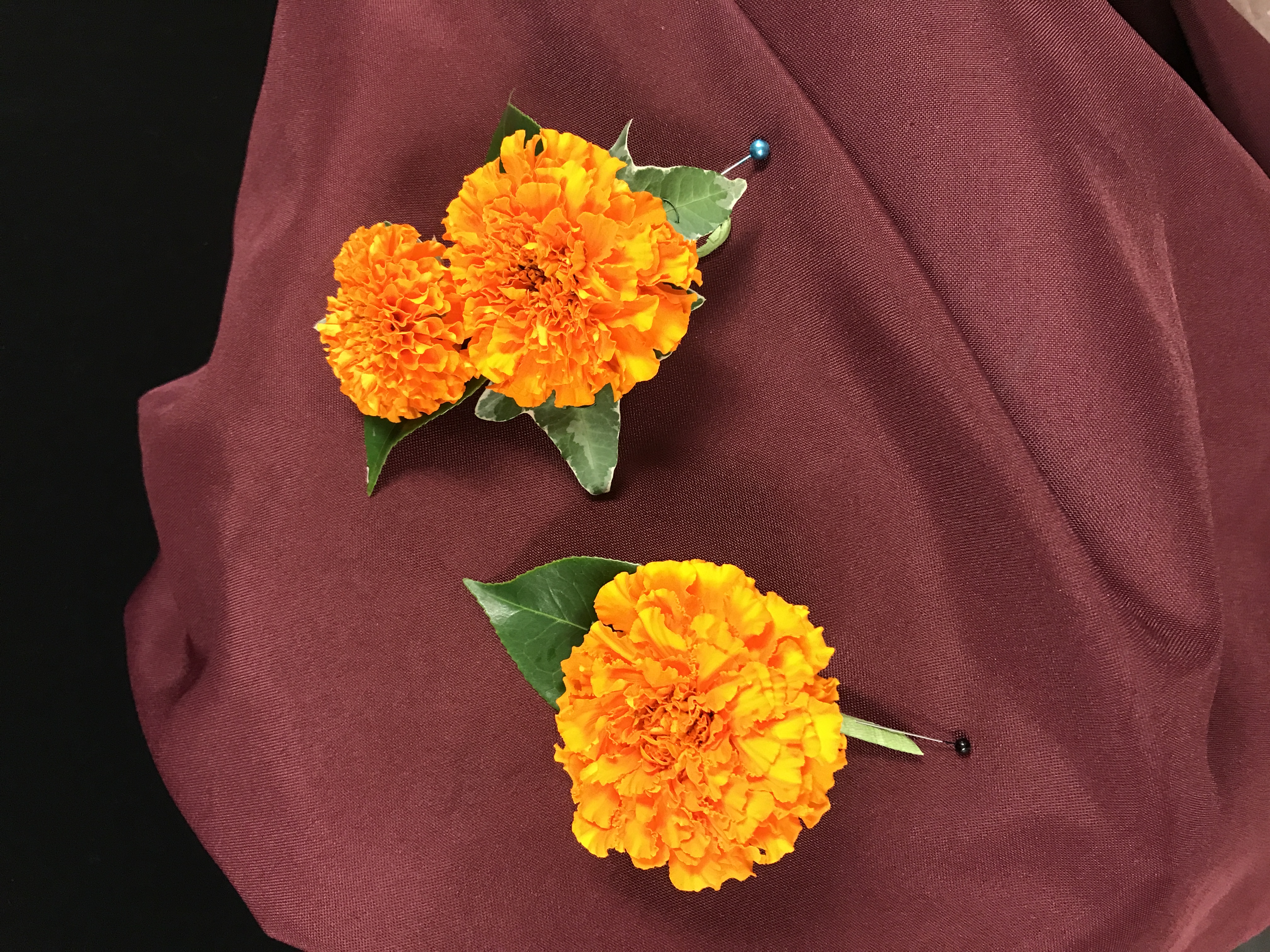
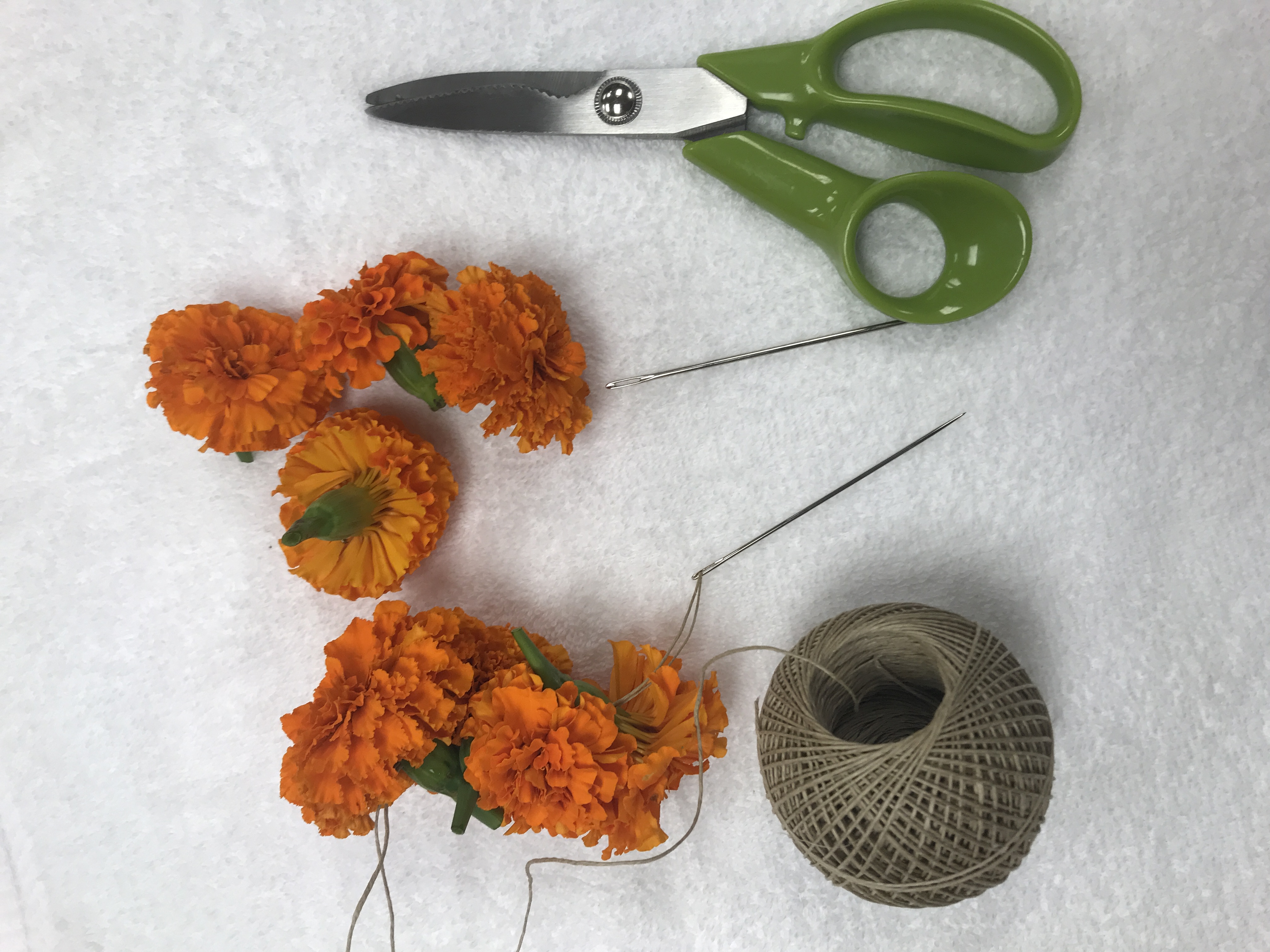
Resources
Stevens, A. B. (1998). Field grown cut flowers: A practical guide and sourcebook, commercial field grown, fresh, and dried cut flower production. Edgerton, WI: Avatar’s World.
Vaughan, M. J. (1988). The complete book of cut flower care. Portland, OR: Timber Press.
Special thanks to the Hindu Temple Society of Mississippi; Patrick Broussard, Susan Deblanc, and Corey Wheeler, MSU Coastal Research and Extension Center; and Connie Belk and Earline Sawyer, MSU Extension Master Floral Designer Volunteers.
The information given here is for educational purposes only. References to commercial products, trade names, or suppliers are made with the understanding that no endorsement is implied and that no discrimination against other products or suppliers is intended.
Publication 3362 (POD-06-25)
By James DelPrince, PhD, Associate Extension Professor, and Christine Coker, PhD, former Associate Extension/Research Professor, Coastal Research & Extension Center.
The Mississippi State University Extension Service is working to ensure all web content is accessible to all users. If you need assistance accessing any of our content, please email the webteam or call 662-325-2262.
